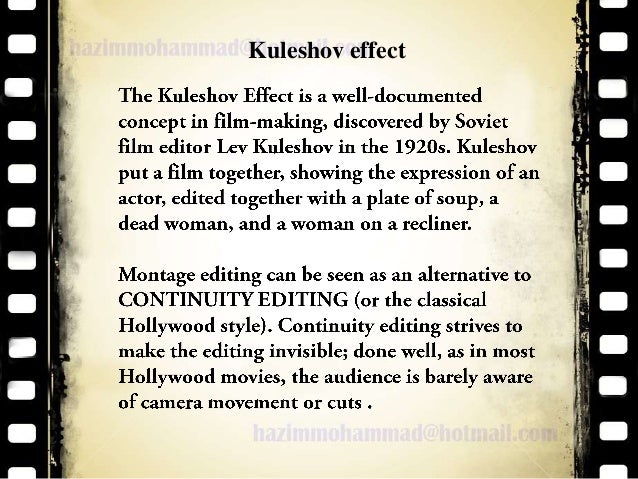Kuleshov effect Soviet Montage Intellectual or dialectical montage Associative or tonal montage
Discuss the following:
- Kuleshov effect
- Soviet Montage
- Intellectual or dialectical montage
- Associative or tonal montage

Kuleshov Effect:
The Kuleshov effect is a film editing effect demonstrated by Soviet filmmaker Lev Kuleshov in the 1910s and 1920s. It is a mental phenomenon by which viewers derive more meaning from the interaction of two sequential shots than from a single shot in isolation. Kuleshov put a film together with a plate of soup and a dead woman on a recliner.
“Point-of-view shots can, but don’t always, align viewers with characters. They help to explain the way characters experience the world, validate character interpretations of events, and provide information about motivation. This was said by Maria Pramaggiore and Tom Wallis, Film: A Critical Introduction,
 Soviet Montage: Soviet montage theory is an approach to understanding and creating cinema that relies heavily upon editing. It is the principal contribution of soviet film theorists to global cinema and brought formalism to bear on filmmaking. Soviet Montage describes cutting together images that aren’t in spatial or temporal continuity. The roots of the montage aesthetic were in the modernist movements that had revolutionized the visual arts in Europe in the early 1900s. By 1910, a group of Russian painters was trying to invent a new kind of art, one that utilized graphic collage to create a kind of shock for the viewer, and the creative use of juxtaposition was becoming widespread in European modernist art, theater, and poetry. After the Soviet revolution, Soviet filmmakers developed a complex set of theories around the use of montage that was quite different from its use in Europe to depict confused, mental states or a rush of events. The Soviet filmmakers' approach contrasted the predominant continuity editing system in which the viewer isn’t aware of the cuts and doesn’t think about the way a film is edited at all. The continuity system (usually used in Hollywood movies) is about telling a story in such a way that it appears to be “telling itself.” Film theorists have often questioned the implications of the “invisibility” of the narrative and possible audience manipulation. And Soviet avant-garde filmmakers were also interested in this because by the 1920s these conventions were already well-established and being adopted by filmmakers around the world.
Soviet Montage: Soviet montage theory is an approach to understanding and creating cinema that relies heavily upon editing. It is the principal contribution of soviet film theorists to global cinema and brought formalism to bear on filmmaking. Soviet Montage describes cutting together images that aren’t in spatial or temporal continuity. The roots of the montage aesthetic were in the modernist movements that had revolutionized the visual arts in Europe in the early 1900s. By 1910, a group of Russian painters was trying to invent a new kind of art, one that utilized graphic collage to create a kind of shock for the viewer, and the creative use of juxtaposition was becoming widespread in European modernist art, theater, and poetry. After the Soviet revolution, Soviet filmmakers developed a complex set of theories around the use of montage that was quite different from its use in Europe to depict confused, mental states or a rush of events. The Soviet filmmakers' approach contrasted the predominant continuity editing system in which the viewer isn’t aware of the cuts and doesn’t think about the way a film is edited at all. The continuity system (usually used in Hollywood movies) is about telling a story in such a way that it appears to be “telling itself.” Film theorists have often questioned the implications of the “invisibility” of the narrative and possible audience manipulation. And Soviet avant-garde filmmakers were also interested in this because by the 1920s these conventions were already well-established and being adopted by filmmakers around the world.
Intellectual/Disatectual Montage: Intellectual Montage means that in the film through the lens of the juxtaposition of the group so that the audience on some of the visual images into a rational understanding. The conflict between the two shots will produce new ideas.
Associative montage — Juxtaposes two seemingly dissociated images to create a third principal idea or concept. Operates on the dialectical principle in which one idea (thesis) is opposed by another (antithesis), leading to a new idea (synthesis)—a tertium quid (third something).
Tonal montage uses the emotional meaning of the shots—not just manipulating the temporal length of the cuts or its rhythmical characteristics—to elicit a reaction from the audience even more complex than from the metric or rhythmic montage.
Associative montage — Juxtaposes two seemingly dissociated images to create a third principal idea or concept. Operates on the dialectical principle in which one idea (thesis) is opposed by another (antithesis), leading to a new idea (synthesis)—a tertium quid (third something).
Tonal montage uses the emotional meaning of the shots—not just manipulating the temporal length of the cuts or its rhythmical characteristics—to elicit a reaction from the audience even more complex than from the metric or rhythmic montage.

Comments
Post a Comment